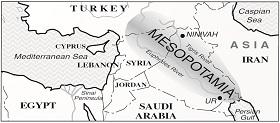Using AI to control energy for indoor agriculture
30 September 2024
Published online 18 February 2013

The current crisis in Syria parallels events that preceded the fall of the Akkadian empire in Mesopotamia more than 4,000 years ago, according to research published recently in the Journal of Archaeological Science1.
The Akkadian empire flourished in the third millennium BC. Sometime around 2,200 BC drought hit, the lands dried and people migrated from urban centres. The government then collapsed, and the mighty empire began to falter in a series of calamities collectively referred to as the third-millennium Mesopotamian urban crisis.
Until now, our understanding of the Mesopotamian urban crisis had been based on archaeological studies of ceramic artefacts and changes in the size of archaeological sites along with what we know about farming practices popular at the time.
But archaeologist Ellery Frahm of the University of Sheffield in the UK and his colleagues used geochemical techniques and rock magnetic analyses to examine trade and the social networks associated with it instead.
The researchers used electron microscopy and chemical analyses to examine 97 obsidian tools excavated earlier from a site called Tell Mozan, dating from the early Akkadian empire to several centuries after its demise. Located in the foothills of the Taurus Mountains in northeastern Syria, the site was known as Urkesh in antiquity, and was densely populated at the height of the Akkadian empire.
What happens to cities when a state falls? How do the residents sustain themselves if that infrastructure collapses?
The tools dating to before 2,200 BC were made of obsidian rock originally quarried from six sites in Eastern Anatolian. This variety suggests that Urkesh was a cosmopolitan city with complex, long distance exchange networks that linked it with civilizations in the Aegean and middle Euphrates.
The tools dated to after 2,200BC, however, came from only two local sources, suggesting that the late third millennium collapse disrupted these trade links.
"Urkesh might have specialised its economy in response to demand for certain commodities, such as metals from the nearby mountains," says Frahm. "With climate shifts and the end of the empire, the inhabitants might have had to refocus their economy on local production and consumption, covering their own needs rather than engaging in specialised long-distance trade."
Some parallels can be drawn to the situation in Syria today. "Some archaeologists contend that the Akkadian Empire was brought down by militarism and that violence ended its central economic role in the region, and a governmental collapse is a real possibility in Syria after nearly two years of fighting," Frahm adds.
Furthermore, contemporary farming in northeastern Syria relies heavily on rainfall, just as farmers did in the Akkadian empire, and climate change is already taking its toll with several severe droughts.
"Those of us who study people and the past are in a unique position to consider what could happen after the immediate crisis ends," says Frahm. "What happens to cities when a state falls? How do the residents sustain themselves if that infrastructure collapses? This is the type of contribution that archaeology can make towards improving the future."
doi:10.1038/nmiddleeast.2013.25
Stay connected: